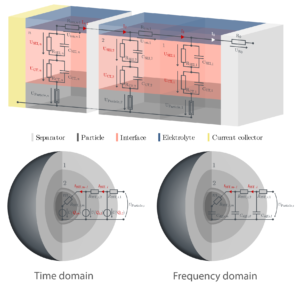Summary:
Transmission line model (TLM) or mixed conducting networks are used frequently for the characterization of porous electrodes based on the electrodes’ impedance data, showing the influence of the porous morphology and of spatially distributed behavior in the frequency domain. For this purpose, transfer functions are used to characterize the TLM, representing the overall polarization behavior of the electrode.
Time-domain simulations are scarce but may be beneficial for the understanding of electrode processes, prediction of battery behavior or even for BMS applications, where state-of-the-art methods neglect spatial distributions. However, the transfer functions cannot be transformed analytically into time-domain. Thus, both the time and the frequency domain model, are transferred into a discretized electrical network. The number of n discrete electrode- and m discrete particle segments can be chosen freely. They affect the precision, resolution and computation time of the model.
With increasing n, the effect of distributed charge transfer and SEI can be reproduced more precisely. The particle discretization m not only affects the solid state transport (SST) branch for low f, but also the roundness of the interfacial semicircles as the SST also has a small effect at higher frequencies. A fit of an electrochemical impedance spectrum (EIS) should thus be carried out with large n and m. In our study, we will elucidate the effects of m and n and show how and up to which point those parameters can be reduced without significantly affecting the overall impedance. As an asymptotical behavior is expected, the limits up to which the model is assumed to be valid are evaluated. Furthermore, lumped SEI and charge transfer parameters (i.e. resistors and capacitors) can be identified. It is noteworthy that those calculated parameters differ strongly from those obtained by standard equivalent circuit (ec) fits and from those obtained by inspection of the semicircles’ diameter. Thus, the parameters obtained by ec fits must not be seen as actual lumped parameters, but as parameters of lumped elements impacted by the porous morphology.
Furthermore, transferring parameters from frequency to time domain is not trivial. Due to the model’s structure, computation time and available memory allows only small n and m, close to the size where the impedance cannot be reconstructed properly anymore. Thus, it is investigated in which way the parameters can be transferred and how they affect the accuracy of a time-domain simulation for both constant current and dynamic load profiles.
We are happy to forward your request / feedback.

